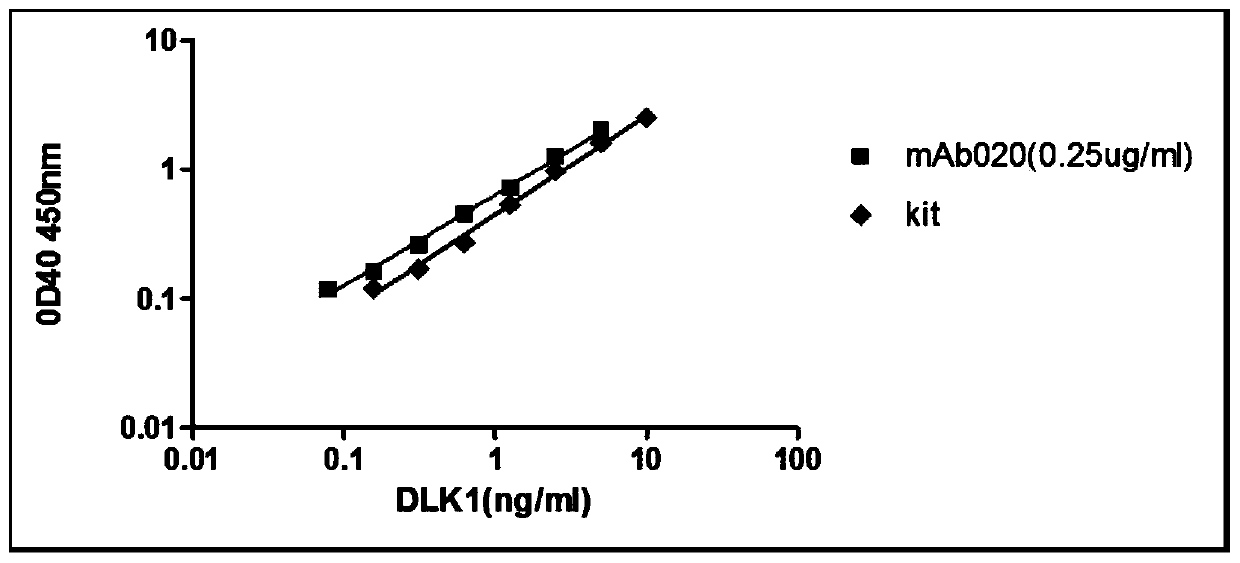ELISA kit for detecting human serum dlk1 protein and application thereof
A technology of kits and human serum, applied in biological testing, measuring devices, material inspection products, etc., can solve the problems of not being able to replace AFP, achieve reliable reference significance, improve sensitivity, high sensitivity and specificity
- Summary
- Abstract
- Description
- Claims
- Application Information
AI Technical Summary
Problems solved by technology
Method used
Image
Examples
Embodiment 1
[0071] Example 1. Establishment, screening and identification of a hybridoma cell line stably secreting anti-DLK1 monoclonal antibody
[0072] Step 1. Preparation of recombinant human DLK1 protein (immune antigen)
[0073] Using PCR technology, the BGH sequence was deleted from the 5' end of the self-built plasmid vector pcDNA3.1B-DLK1 (pcDNA3.1B sequence, and the T7 promoter, XhoⅠ, NotⅠ, EcoRⅤ and EcoRI restriction sites were added, and 3 flags were introduced. tag, the transformed vector is more conveniently applied to gene expression) to amplify the gene fragment encoding the human DLK1 secretory region sequence (DLK1solubleregion, 24-303aa), add the kappa signal peptide sequence to the front, and add the His 6tag tag sequence to the rear to construct The insert fragment kappa sp-DLK1soluble reg-His 6tag was correctly identified by sequence determination, and after being treated with restriction endonucleases, it was cloned into the expression vector pCPC(KpnI / NotI) (purc...
Embodiment 2
[0084] Example 2. In vitro preparation and purification of anti-DLK1 monoclonal antibody
[0085] The established 019 / 020 hybridoma cells were expanded and cultured in serum-free medium until the cell concentration reached 10 5 Stop adding liquid when cells / ml is above, and continue culturing until the cell culture medium turns yellow. The culture medium was collected and centrifuged at 1500 rpm for 10 minutes. The supernatant was filtered through a 0.45 μm filter membrane and stored at 4°C or -20°C for future use or directly used for the separation and purification of monoclonal antibodies in the next step.
[0086] Step 6. The hybridoma cells are amplified and cultured, the culture medium is collected, and the anti-human DLK1 monoclonal antibody is separated and purified by affinity chromatography.
[0087] In this example, the separation and purification of anti-DLK1 monoclonal antibody (019 / 020) adopts affinity chromatography. The purification steps are as follows: the...
Embodiment 3
[0088] Example 3, Preparation of human serum DLK1 protein enzyme-linked detection kit
[0089] 1. Solid phase carrier coated with antigen
[0090] The solid phase carrier can be selected from polystyrene or polyvinyl chloride, in the form of a 96-well plate or a microtiter plate.
[0091] Coat 100 ul / well (0.25 ug / ml) of the anti-human DLK1 monoclonal antibody (019 / 020) prepared in Example 2 into polystyrene or polyvinyl chloride reaction wells.
[0092] 2. Solution preparation
[0093] 2.1 Preparation of coating buffer
[0094] The coating solution uses 1*PBS. The coating solution is prepared by adjusting the pH to 7.3 with sodium hydroxide and then adjusting the volume to 1000ml with 8.18g sodium chloride, 0.2g potassium chloride, 3.58g 12 hydrate disodium hydrogen phosphate, 0.24g potassium dihydrogen phosphate .
[0095] 2.2 Preparation of enzyme conjugates (enzyme-labeled antigen)
[0096] There are two types of enzyme-labeled antigens, including:
[0097] Enzyme...
PUM
 Login to View More
Login to View More Abstract
Description
Claims
Application Information
 Login to View More
Login to View More - R&D
- Intellectual Property
- Life Sciences
- Materials
- Tech Scout
- Unparalleled Data Quality
- Higher Quality Content
- 60% Fewer Hallucinations
Browse by: Latest US Patents, China's latest patents, Technical Efficacy Thesaurus, Application Domain, Technology Topic, Popular Technical Reports.
© 2025 PatSnap. All rights reserved.Legal|Privacy policy|Modern Slavery Act Transparency Statement|Sitemap|About US| Contact US: help@patsnap.com



